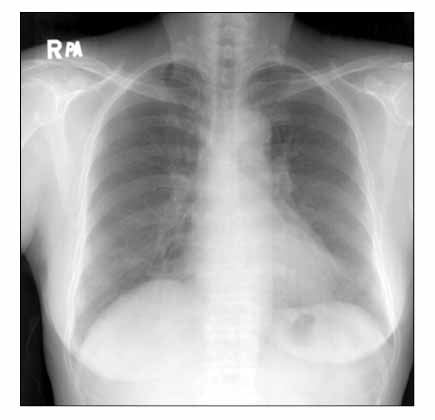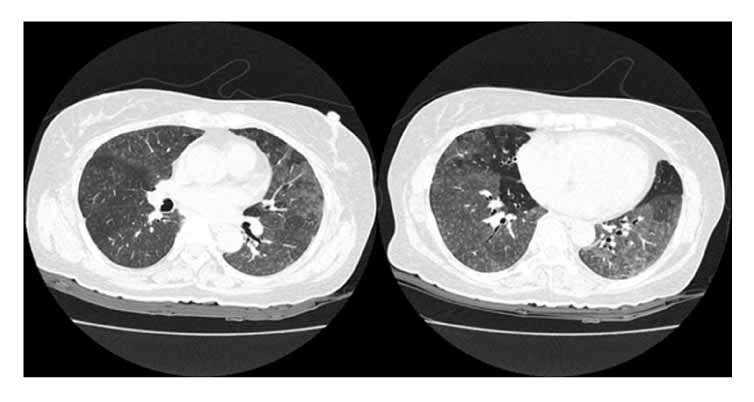Tuberc Respir Dis.
2009 Jan;66(1):37-41.
Two Cases of Hot Tub Lung in Bodyscrubbers Working in a Public Bath
- Affiliations
-
- 1Department of Internal Medicine, Paik Hospital, Inje University Collage of Medicine, Seoul, Korea. chsbong@paik.ac.kr
- 2Department of Pathology, Paik Hospital, Inje University Collage of Medicine, Seoul, Korea.
Abstract
- Hot tub lung has been described as a pulmonary illness associated with exposure to nontuberculous mycobacteria, mainly hot bathtub water contaminated with Mycobacterium avium complex (MAC) and hence the name. Although not entirely clear, its etiology has been thought to involve either an infection or a hypersensitivity pneumonitis secondary to MAC. Herein, we describe 2 female patients (60 and 53 years old) admitted to our hospital with hot tub lung, and both of whom worked in a public bath. Both women were initially admitted following several months of exertional dyspnea and cough. The patients had been working as body-scrubbers in a public bath for several years. Their chest CT scans showed bilateral diffuse ground-glass opacities with multifocal air-trappings and poorly defined centrilobular nodules in both lungs. Pathological findings from lung specimens revealed small non-necrotizing granuloma in the lung parenchyme with relatively normal-looking adjacent alveoli. Discontinuation of working in the public bath led to an improvement in symptoms and radiographic abnormalities, without antimycobacterial therapy.
Keyword
MeSH Terms
Figure
Reference
-
1. Hanak V, Kalra S, Aksamit TR, Hartman TE, Tazelaar HD, Ryu JH. Hot tub lung: presenting features and clinical course of 21 patients. Respir Med. 2006. 100:610–615.2. Khoor A, Leslie KO, Tazelaar HD, Helmers RA, Colby TV. Diffuse pulmonary disease caused by nontuberculous mycobacteria in immunocompetent people (hot tub lung). Am J Clin Pathol. 2001. 115:755–762.3. Sood A, Sreedhar R, Kulkarni P, Nawoor AR. Hypersensitivity pneumonitis-like granulomatous lung disease with nontuberculous mycobacteria from exposure to hot water aerosols. Environ Health Perspect. 2007. 115:262–266.4. Pham RV, Vydareny KH, Gal AA. High-resolution computed tomography appearance of pulmonary Mycobacterium avium complex infection after exposure to hot tub: case of hot-tub lung. J Thorac Imaging. 2003. 18:48–52.5. Barrios RJ. Hypersensitivity pneumonitis: histopathology. Arch Pathol Lab Med. 2008. 132:199–203.6. Marchetti N, Criner K, Criner GJ. Characterization of functional, radiologic and lung function recovery post-treatment of hot tub lung: a case report and review of the literature. Lung. 2004. 182:271–277.7. Marras TK, Wallace RJ Jr, Koth LL, Stulbarg MS, Cowl CT, Daley CL. Hypersensitivity pneumonitis reaction to Mycobacterium avium in household water. Chest. 2005. 127:664–671.8. Rickman OB, Ryu JH, Fidler ME, Kalra S. Hypersensitivity pneumonitis associated with Mycobacterium avium complex and hot tub use. Mayo Clin Proc. 2002. 77:1233–1237.9. Glazer CS, Martyny JW, LEE B, Sanchez TL, Sells TM, Newman LS, et al. Nontuberculous mycobacteria in aerosol droplets and bulk water samples from therapy pools and hot tubs. J Occup Environ Hyg. 2007. 4:831–840.
- Full Text Links
- Actions
-
Cited
- CITED
-
- Close
- Share
- Similar articles
-
- Hot Tub Lung Due to Mycobacterium Avium Complex in a Public Bath
- A Case of Hot Tub Lung
- Pseudomonas Folliculitis Suggestively Caused by Water from Bathing Tub: A Case Report
- Forensic Review of Hot Bath-Related Death in the Elderly: Focused on Japanese Studies
- The Effect of Cold Baths after Hot Baths on Spermatogenesis in Rat Testicles





